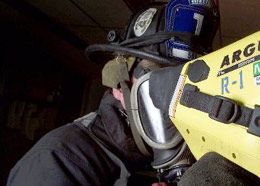By Jamie Thompson
FireRescue1 News Editor
 AP Photo/Jeff Zelevansky An Elizabeth, N.J., firefighter demonstrates the use of a thermal imaging camera in this file photo. |
In just a few years, thermal imaging cameras have become essential tools for the fire service.
From locating trapped victims or even firefighters at an incident to identifying the seat of the fire, TICs are becoming more and more commonplace in departments across the country.
But despite the tremendous benefits they offer, there is an issue that can prevent departments from using TICs to their fullest potential: a lack of standardization in the tools, meaning one TIC can have completely different operating functions to another.
But with NFPA 1801 Standard on Thermal Imagers for the Fire Service set to come into effect in two years, all this could change.
One of the leading figures behind the proposed code is Bob Athanas, a senior instructor at SAFE-IR, INC., which offers thermal imaging training for firefighters.
Athanas and his associates have identified nearly a dozen different colors used for the on/off switches of different cameras. That does not even begin to address the other, more complex issues associated with image interpretation.
Public comments
During the public review stage of the draft document, which closed in January, more than 150 comments and suggestions were submitted. Before the standard is finalized, it will again be available for public comment and input. Although the fire service is represented on the committee, the opportunity exists for many more individuals to participate in the process by viewing the proposed document online, submitting comments and offering input.
The process to standardize fire service thermal imagers began back in December 2004, when NIST researchers in Washington conducted a workshop to determine the need for fire and emergency services thermal imaging cameras.
“The number one priority that came out of that workshop was that training was an absolute necessity,” said Athanas. “But because every single camera is different, it was hard to create a standard training program for them.”
Athanas, a firefighter of more than 20 years with the FDNY, became the chairman of a working group that was formed out of the workshop to help advise the NFPA on creating a suitable standard.
The group met 17 times over the course of the following two years. One of its main goals is to develop a standard or basic level of operation in every camera to simplify training and use.
 The camera can provide you with a lot of information, but if you don’t know what you’re looking at, it can obviously cause problems. The camera can provide you with a lot of information, but if you don’t know what you’re looking at, it can obviously cause problems.  | ||
| — Brad Kays ISG Thermal Systems | ||
“What happens in a lot of cases is thermal imagers have been purchased by a fire department, but frequently users don’t understand their full potential,” Athanas said. “In many cases, they are sitting on the fire truck and just not being used.”
Less expensive
Despite the variations in operation from camera to camera, the increase in the number of tools on the market has been positive for fire departments in terms of cost.
“Back in the 1980s, there was primarily only one manufacturer of TICs for firefighters, and that was the case for a number of years” said Brad Kays, vice-president of marketing at ISG Thermal Systems. “But as technology has changed, there are now a number of companies that have been able to enter the market.”
Ga.-based ISG Thermal Systems is one of them, and the number of new manufacturers has been positive for the fire service, according to Kays.
“Cameras are substantially smaller than they used to be and substantially less expensive than they were 15 even 10 years ago,” he said.
The bigger market means greater choice for departments looking to acquire a TIC, which for some can be overwhelming.
The key piece of advice Kays offers is to carry out head-to-head comparisons of different models.
“If you’re spending something like $10,000 on a camera, it’s something you should really do,” he said. “When you’re doing these evaluations, they need to be carried out in real scenarios, whether it’s a burn building or a training facility.”
In-depth training is obviously vital, he added.
“The camera can provide you with a lot of information, but if you don’t know what you’re looking at, it can obviously cause problems,” Kays said.











